Thermalright Ultima-90: Small Wonder?
by Wesley Fink on August 20, 2007 2:00 AM EST- Posted in
- Cases/Cooling/PSUs
Thermalright Ultima-90
Thermalright specializes in cooling for the enthusiast market. Their CPU coolers are very well known, but they also market chipset, VGA, and RAM coolers, as well as thermal paste. Thermalright has always emphasized their design capabilities in the cooling market, and our test results confirm the excellent performance of their products. They also point to their advanced manufacturing processes, and they are ISO-9000 certified manufacturing plants.
Most hobbyists first heard of Thermalright when their SK-6 cooler appeared in the summer of 2001 and started winning most of the heatsink roundups. Since then Thermalright has become a well-respected name in high-end air cooling. Thermalright produced several well-known heatsinks for the AMD K8 and Pentium 4 sockets, such as the XP-120 and XP-90 heatsinks. You bought the Thermalright heatsink and paired it with the 120mm or 90mm fan of your choice - for low noise or massive air flow or some combination that met your needs. This approach has continued with their current offerings.
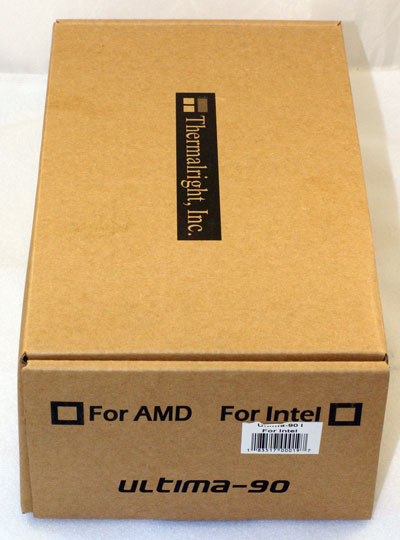
Product has been the emphasis at Thermalright, and packaging generally consists of the same-size sturdy brown box with custom foam inserts to protect the cooler. That has not changed with the Ultima-90.
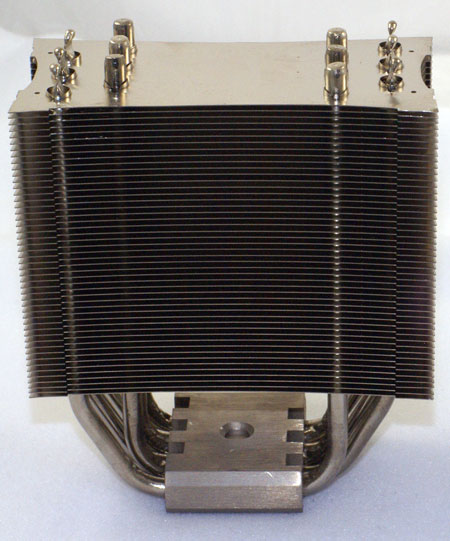
The cooler looks like an Ultra-120 eXtreme that has been on a diet. There are the same six heatpipe loops (12 risers) seen in the eXtreme, but the Ultima-90 body is closer in size to the Ultra-90. The Ultra-90 is 102x45x147, where the Ultima-90 is 115x55x139. That makes the Ultima-90 a little wider and deeper than the Ultra-90, but about 8mm shorter than the Ultra. It is smaller in all dimensions than the top-performing Ultra-120 eXtreme which is 132x63.44x160. Keep in mind that the eXtreme is already one of the smallest of the full heatpipe tower coolers and you will get a good idea of how small the Ultima-90 is relative to other heatpipe towers we have reviewed.
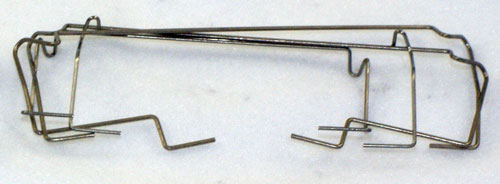
The Ultima-90 is also the first Thermalright we have tested with four sets of fan wire mounting holes. This means with the right fan wires you can mount two fans in a push pull configuration. Also unique is the support for both 120mm or 92mm fans. The slightly wider width provides a solid base for your favorite 120mm fan or a 92mm fan nestles solidly in the fin grooves. Two sets of fan wires are included - one set for mounting 120mm and the other for 92mm.
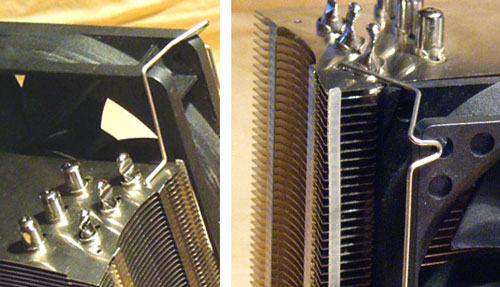
We have complained in past reviews that Thermalright limits the type of fans that can be used by supplying fan wires that would only mount postless fans. Thermalright has clearly been listening, because the new design can mount fans with posts or postless fans. Almost any 120mm or 90mm fan will mount on the new Ultima-90.

Accessories include a mounting base for under the motherboard and a top plate with spring loaded screws for Intel socket 775 and a clip for AM2 sockets. The mounting kit for AMD 745/939/940 is not included, but it is available as an optional accessory called the "939 Bolt Thru Kit". Thermalright also includes a small tube of premium thermal paste and installation instructions.
Mounting is much like other Thermalright coolers we have reviewed. The motherboard must be removed from the case for Intel 775 and a backplate is positioned through the holes in the motherboard. Thermal paste is applied to the CPU and the 775 holder is passed through the cooler and unfolded. The holder is then attached to the threaded screw holes on the backplate by screwing in the four spring-mounted screws attached to the holder.

The final installation is very secure on Intel socket 775. The Ultima-90 weighs just 460g compared to the 790g of the eXtreme. The lighter weight helps in the feeling of security with the Ultima. The mounted heatsink has no tendency to shift or turn on its axis. Those who worry about the dangling weight of the large heatpipe towers will also be happier with the lower profile and weight that is only about a pound compared to the two pounds seen in many large heatpipe towers.
IMPORTANT: The test kit is a pre-production model. The Ultima-90 is now for sale and performance results have been confirmed with a production Ultima-90 cooler. The final production kit contains mounting parts that are different from the pre-production package. Please check current installation instructions at the Thermalright website for information on the contents of the shipping Ultima-90 kit.
Specifications
Our test system is Intel socket 775, but the Ultima-90 will also mount on the AM2 socket as well. Socket 754/939/940 requires an optional 939 Bolt Thru Kit.
Thermalright does not include fans with their top-line coolers so we selected a top 120mm and a 92mm fan for testing with the Ultima-90. For the 120mm fan we used the excellent Scythe S-FLEX SFF21F tested with the Ultra-120 eXtreme.
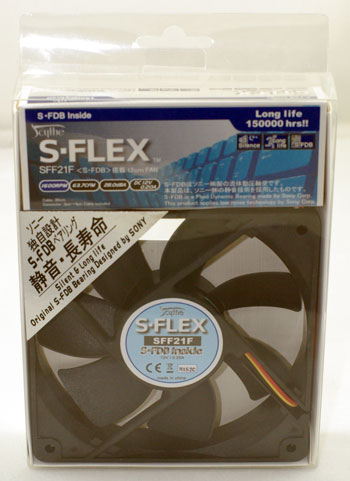
For the 92mm fan we chose the Panasonic Panaflo H1A, which is a very popular fan with cooling enthusiasts looking for high output and low noise with a history of long fan life. We extend our thanks to Frozen CPU for providing the fans for the Ultima-90 tests.

The Ultima-90 is both smaller and lighter than the top-line Ultra-120 eXtreme, but it features the same number of heat pipes in a similar configuration. With the ability to mount either 120mm or 92mm fans, the question is how much the size and weight shrink have compromised performance? It is great that the Ultima-90 is smaller and lighter than any of the top 120mm heatpipe towers, but unless the Ultima-90 performs close to the same level as the best 120 coolers it becomes consideration of whether what you give up justifies the savings in size or money. The Ultima-90, at around $50 retail, is $15 cheaper than the top Ultra-120 eXtreme.
The EVGA 680i is a difficult to fit board due to the copper-finned heatsink and fan cooling the Northbridge. You would expect the smaller and lighter Thermalright Ultima-90 to be an easier fit than the large coolers we have tested with 120mm fans. This is true since the cooler is only 115 mm deep, so that a 120mm fan overlaps each side just slightly. The Ultima-90 fit comfortably on the EVGA 680i. Installation was also an easy task on the ASUS Striker and ASUS Commando, and on the two new P35 boards - the ASUS P5K Deluxe and P5K3 Deluxe. The P5K3 Deluxe will likely become a fit test for any motherboard, since the heatpipes completely circle the CPU socket and connect various cooling heatsinks around the CPU socket.
The height of 139mm is also shorter than most 120 heatpipe towers. This means the Ultima-90 will fit some thin cases that couldn't handle the Thermalright Ultra-120 eXtreme, the Tuniq 120, or the Scythe Infinity. However, the Ultima-90 still cannot be considered a flat cooler. You will need to measure carefully to make sure it will fit your HTPC or rack-mount case
Thermalright specializes in cooling for the enthusiast market. Their CPU coolers are very well known, but they also market chipset, VGA, and RAM coolers, as well as thermal paste. Thermalright has always emphasized their design capabilities in the cooling market, and our test results confirm the excellent performance of their products. They also point to their advanced manufacturing processes, and they are ISO-9000 certified manufacturing plants.
Most hobbyists first heard of Thermalright when their SK-6 cooler appeared in the summer of 2001 and started winning most of the heatsink roundups. Since then Thermalright has become a well-respected name in high-end air cooling. Thermalright produced several well-known heatsinks for the AMD K8 and Pentium 4 sockets, such as the XP-120 and XP-90 heatsinks. You bought the Thermalright heatsink and paired it with the 120mm or 90mm fan of your choice - for low noise or massive air flow or some combination that met your needs. This approach has continued with their current offerings.

Product has been the emphasis at Thermalright, and packaging generally consists of the same-size sturdy brown box with custom foam inserts to protect the cooler. That has not changed with the Ultima-90.

The cooler looks like an Ultra-120 eXtreme that has been on a diet. There are the same six heatpipe loops (12 risers) seen in the eXtreme, but the Ultima-90 body is closer in size to the Ultra-90. The Ultra-90 is 102x45x147, where the Ultima-90 is 115x55x139. That makes the Ultima-90 a little wider and deeper than the Ultra-90, but about 8mm shorter than the Ultra. It is smaller in all dimensions than the top-performing Ultra-120 eXtreme which is 132x63.44x160. Keep in mind that the eXtreme is already one of the smallest of the full heatpipe tower coolers and you will get a good idea of how small the Ultima-90 is relative to other heatpipe towers we have reviewed.

The Ultima-90 is also the first Thermalright we have tested with four sets of fan wire mounting holes. This means with the right fan wires you can mount two fans in a push pull configuration. Also unique is the support for both 120mm or 92mm fans. The slightly wider width provides a solid base for your favorite 120mm fan or a 92mm fan nestles solidly in the fin grooves. Two sets of fan wires are included - one set for mounting 120mm and the other for 92mm.

We have complained in past reviews that Thermalright limits the type of fans that can be used by supplying fan wires that would only mount postless fans. Thermalright has clearly been listening, because the new design can mount fans with posts or postless fans. Almost any 120mm or 90mm fan will mount on the new Ultima-90.

Accessories include a mounting base for under the motherboard and a top plate with spring loaded screws for Intel socket 775 and a clip for AM2 sockets. The mounting kit for AMD 745/939/940 is not included, but it is available as an optional accessory called the "939 Bolt Thru Kit". Thermalright also includes a small tube of premium thermal paste and installation instructions.
Mounting is much like other Thermalright coolers we have reviewed. The motherboard must be removed from the case for Intel 775 and a backplate is positioned through the holes in the motherboard. Thermal paste is applied to the CPU and the 775 holder is passed through the cooler and unfolded. The holder is then attached to the threaded screw holes on the backplate by screwing in the four spring-mounted screws attached to the holder.

The final installation is very secure on Intel socket 775. The Ultima-90 weighs just 460g compared to the 790g of the eXtreme. The lighter weight helps in the feeling of security with the Ultima. The mounted heatsink has no tendency to shift or turn on its axis. Those who worry about the dangling weight of the large heatpipe towers will also be happier with the lower profile and weight that is only about a pound compared to the two pounds seen in many large heatpipe towers.
IMPORTANT: The test kit is a pre-production model. The Ultima-90 is now for sale and performance results have been confirmed with a production Ultima-90 cooler. The final production kit contains mounting parts that are different from the pre-production package. Please check current installation instructions at the Thermalright website for information on the contents of the shipping Ultima-90 kit.
Specifications
Our test system is Intel socket 775, but the Ultima-90 will also mount on the AM2 socket as well. Socket 754/939/940 requires an optional 939 Bolt Thru Kit.
| Thermalright Ultima-90 Specifications | |
| Heatsink | |
| Dimensions | 115(W) X55 (D) X 139(H)mm |
| Weight | 460g |
| Material | Nickel-plated Copper Aluminum |
| Heatpipes | Six looped (twelve risers) Plated Copper Heatpipes |
| Fan Configuration | Supports 120mm or 92mm fans |
| Fan Types Supported | Any Fan - Post or Postless |
Thermalright does not include fans with their top-line coolers so we selected a top 120mm and a 92mm fan for testing with the Ultima-90. For the 120mm fan we used the excellent Scythe S-FLEX SFF21F tested with the Ultra-120 eXtreme.
| 120mm Fan Specifications | |
| Model | Scythe S-Flex SFF21F |
| Fan Size | 120mm x 120mm x 25mm |
| Fan Type | Sony Fluid Dynamic Bearing |
| Maximum Fan Speed | 1600 RPM |
| Maximum Noise Level | 28.0 dB(A) |
| Maximum Airflow | 63.7 CFM |
| Fan Life | 150,000 Hours (vs. 50,000 hours for ball bearing) |
| Weight | 180g (Fan Only) |

For the 92mm fan we chose the Panasonic Panaflo H1A, which is a very popular fan with cooling enthusiasts looking for high output and low noise with a history of long fan life. We extend our thanks to Frozen CPU for providing the fans for the Ultima-90 tests.
| 92mm Fan Specifications | |
| Model | Panaflo H1A 92mm (BX) with RPM Sensor |
| Fan Size | 92mm x 92mm x 25mm |
| Fan Type | Hydro Wave (Fluid) Bearing |
| Maximum Fan Speed | 2850 RPM |
| Maximum Noise Level | 35.0 db |
| Maximum Airflow | 56.8 CFM |

The Ultima-90 is both smaller and lighter than the top-line Ultra-120 eXtreme, but it features the same number of heat pipes in a similar configuration. With the ability to mount either 120mm or 92mm fans, the question is how much the size and weight shrink have compromised performance? It is great that the Ultima-90 is smaller and lighter than any of the top 120mm heatpipe towers, but unless the Ultima-90 performs close to the same level as the best 120 coolers it becomes consideration of whether what you give up justifies the savings in size or money. The Ultima-90, at around $50 retail, is $15 cheaper than the top Ultra-120 eXtreme.
The EVGA 680i is a difficult to fit board due to the copper-finned heatsink and fan cooling the Northbridge. You would expect the smaller and lighter Thermalright Ultima-90 to be an easier fit than the large coolers we have tested with 120mm fans. This is true since the cooler is only 115 mm deep, so that a 120mm fan overlaps each side just slightly. The Ultima-90 fit comfortably on the EVGA 680i. Installation was also an easy task on the ASUS Striker and ASUS Commando, and on the two new P35 boards - the ASUS P5K Deluxe and P5K3 Deluxe. The P5K3 Deluxe will likely become a fit test for any motherboard, since the heatpipes completely circle the CPU socket and connect various cooling heatsinks around the CPU socket.
The height of 139mm is also shorter than most 120 heatpipe towers. This means the Ultima-90 will fit some thin cases that couldn't handle the Thermalright Ultra-120 eXtreme, the Tuniq 120, or the Scythe Infinity. However, the Ultima-90 still cannot be considered a flat cooler. You will need to measure carefully to make sure it will fit your HTPC or rack-mount case










38 Comments
View All Comments
Rick1 - Sunday, August 26, 2007 - link
In a couple of post above the questions are asked Why run one of these coolersMy answer is simple
Quiet and cool running system
The only fan I hear is the One installed in the hard drive compartment of this P182B case
( cooling 4 drives. 2x raptors and 2x Barracuda 7200.10 SATA 3.0Gb/s 500-GB )
With 2 fans S-Flex blowing in and the stock two exhaust fans
This Q6600 runs at 32Cto35C and has never gone over 48C under a full load
I was never able to get the stock H/S below 50C on warm days
jnk - Thursday, October 18, 2007 - link
question for the reviewer:when you reviewed the ultima-90, when mounted were you able to twist it? I recently bought one and i can twist it even while its locked and the screws are tight. I emailed thermalright about it and they that its normal.
Patvs - Saturday, August 25, 2007 - link
This is the best CPU cooler review on the net! I have one question though.In the Noise Level test, some coolers are tested with low and high RPM settings.
For example the Tuniq Tower 120 @1000 RPM and @2100 RPM. However the Thermaltake Big Typhoon VX is only tested @2000 RPM.
Is the HIGH RPM setting always used for the Temperature Tests (IDLE and LOAD)?? Or do you use the LOW RPM setting as default for the temperature tests? *confused* If HIGH: it shows the Tuniq is really quiet at LOW RPM, but you show its cooler potential in temperature in HIGH RPM? How does it cool at LOW RPM? (or if LOW: how much does the temperature decrease if the cooler is at HIGH RPM) Also I would love to see a test with TWO fans hooked up to some of these coolers in the future.
Patvs - Saturday, August 25, 2007 - link
Edit: You state you use stock speed RPM settings for the temperature tests.So why use 2000 RPM for the Big Typhoon VX? Isn't its stock speed 1300 RPM. (it is for the Big Typhoon non-VX version without the fan controller)
muddocktor - Wednesday, August 22, 2007 - link
As always, a good heatsink review by you, Wesley. But I have a question about the Thermalright samples that you all get for review. Do you receive these directly from Thermalright or are they procured from an authorized reseller such as Sidewinder Computers or Newegg from actual shipping production? The reason I ask is that while I find the engineering and design of Thermalright's heatsinks to be top-notch, I have personally found that their base finish to be spotty. I own or have owned 2 XP90's, an XP90-C, SI 120, Ultra 120, and an Ultra 120 eXtreme (all bought at retail except the SI 120, which was bought used) and of those the only ones that had a half decent base finish that was usable as-is were the XP90-C and SI 120. The others either had a fairly poor base finish with visible machining marks left in them and in the case of the U-120, an absolutely horrible base finish with a ridge left on one side of the base. The XP-90's also had very concave bases too. All saw improved to much improved performance after giving the base a lap job. If you are getting your review samples directly from Thermalright instead of from a vendor that handles their heatsinks, I am sure that the samples you receive are thoroughly checked for finish before sending them out to you and aren't truly representative of what is actually going out for sale through normal channels. It would be interesting to see if you could get some samples from someone online that didn't know they were going to Anandtech (to minimize the chance of cherry picking the heatsinks) and do a consistency review showing differences (or lack of) in performance of production line Thermalright heatsinks.Also, I have heard the thing Thermalright has put out about the concaveness of their bases being engineered into their design and don't buy that a bit. I think that is just something the salesmen have thought up to cover inconsistencies in the base finish from their manufacturer and my experience (so far) has proved out for me at least that a lapped, flat base works better on both LGA775 and socket 939 systems. Other than the base finish though, I find that Thermalright makes the best overall line of premium aircooling equipment on the market.
Wesley Fink - Wednesday, August 22, 2007 - link
We first tested the Ultima-90 with a pre-production cooler. Results were then verified with a Retail cooler from a stocking retailer. Where there have been questions about items being "hand-picked" we often verify results with a retail sample.In the case of the Ultima-90 the performance of the Thermalright-supplied Ultima-90 and the one off the Retail shelf were exactly the same.
muddocktor - Sunday, September 2, 2007 - link
Thank you for the answer answer on your samples you test, Wesley. I guess I just have bad luck in the base finishes I get on the Thermalright heatsinks I buy then. But since I know how to lap the base anyways it's no big problem for me. Thermalright does make some truly excellent products for cooling highly overclocked cpus.Wesley Fink - Monday, September 3, 2007 - link
Thermalright is not alone in advocating convex bases. Swiftech has moved from promoting flat, mirror-finish bases to convex bases with a finish not as good. They call them their bow base and claim 2 to 4C better performance with the "bow".Engineers have found that the convex base (fat center) mates tighter in the area of the CPU under the cap. Also Intel manufactures caps that are not flat by design - conncave, convex, and wave designs are all used in certain processors. Research shows the convex cooler base mates best with any of these 3 Intel cap types.
The point is this is not a marketing story, as you will see as we go into water-cooling in more detail. Lapping a convex base Thermalright can DROP performance by 2 to 4C.
customcoms - Friday, August 24, 2007 - link
Any chance you guys will be reviewing an Ultra-90? The reason I ask is because silicon valley computers often has these heatsinks in stock and on sale for $15...that seems like a great bargain to me especially when the bigger brothers, the Ultra-120 and 120 eXtreme, retail for upwards of $50. I would really like to know if spending the extra money for an Ultima-90 or Ultra-120 is even worth the performance increase...dm0r - Tuesday, August 21, 2007 - link
Great review Wesley, as aways.